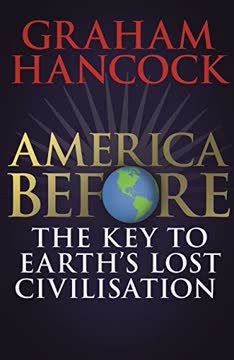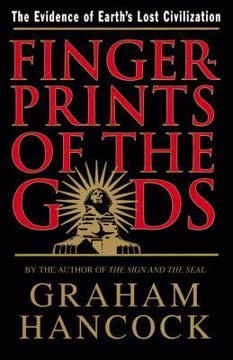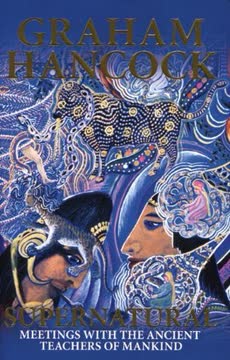Key Takeaways
1. America's Ice Age Prehistory Is Radically Misunderstood
Far from being very recent, it is beginning to look as though the human presence in the Americas may be very old—perhaps more than 100,000 years older than has hitherto been believed.
Challenging the orthodoxy. The traditional view that the Americas were among the last continents inhabited by humans is crumbling. New evidence suggests a human presence far earlier than previously thought, potentially exceeding 100,000 years. This extended timeline necessitates a reevaluation of all pre-Columbian monuments and cultural developments.
Rewriting the narrative. The Americas were physically, genetically, and culturally isolated from the Old World around 12,000 years ago, when rising sea levels submerged the Bering Land Bridge. Any connections between the Americas and the Old World predating this separation cannot be attributed to recent European influence or mere coincidence.
A quest for a lost civilization. The author embarks on a quest to uncover evidence of a lost civilization in the Americas, akin to the fabled Atlantis, destroyed at the end of the Ice Age. This investigation involves gathering and analyzing new evidence from various scientific fields, challenging the established paradigm of American prehistory.
2. Serpent Mound: A Key to Ancient American Cosmology
Some call it a Manitou. But I’d go further. I’d say our Serpent is Gitché Manitou—the Great Spirit and ancestral guardian of the ancient people.
A sacred landscape. Serpent Mound, located in southern Ohio, is the finest surviving example of a prehistoric animal effigy mound in North America. The mound is situated within an ancient impact crater, adding to the site's mystique and spiritual significance. The area is characterized by magnetic and gravity anomalies, underground caverns, streams, and sinkholes, which the ancients may have viewed as entrances to the underworld.
Earth and sky. The Serpent Mound's orientation aligns with the summer solstice sunset, suggesting a deliberate connection between the earthwork and celestial events. This alignment highlights the ancient builders' understanding of astronomy and their reverence for the cosmos.
Manitou. The Native American concept of Manitou, a formless but sentient force animating all life, is central to understanding the significance of Serpent Mound. The mound is not merely an artistic creation but a manifestation of this spiritual power, connecting the physical and spiritual landscapes.
3. The Clovis First Theory Suppressed Evidence of Ancient Americans
Questions of early man in America became virtually taboo, and no anthropologist desirous of a successful career would tempt the fate of ostracism by intimating that he had discovered indications of respectable antiquity for the Indian.
The Hrdlička effect. For much of the 20th century, archaeologist Aleš Hrdlička suppressed any claims of great human antiquity in the Americas. This created a climate of fear, where researchers risked their careers by challenging the prevailing view of recent human arrival.
Clovis First. The discovery of Clovis points in association with extinct Ice Age fauna led to the "Clovis First" theory, which posited that the Clovis people were the first inhabitants of the Americas. This theory became entrenched orthodoxy, stifling alternative viewpoints and research.
Challenging the paradigm. Sites like Monte Verde, Meadowcroft, and Bluefish Caves provided evidence of human presence in the Americas predating Clovis. These discoveries challenged the Clovis First theory and forced a gradual shift in archaeological thinking, though not without resistance and personal attacks on the researchers involved.
4. Ancient DNA Reveals Surprising Connections
With vast convolutions Draco holds / Th’ ecliptic axis in his scaly folds.
Denisovan legacy. Ancient DNA studies reveal that Native Americans share genetic material with Denisovans, an archaic human species closely related to Neanderthals. This suggests interbreeding between the ancestors of Native Americans and Denisovans in the remote past.
Draco. The constellation Draco, depicted as a serpent in many ancient cultures, may have served as a celestial blueprint for Serpent Mound. This suggests a connection between the Americas and the Old World, with the effigy mirroring the patterns of stars in the sky.
Thuban. The ancient north star Thuban, located in the constellation Draco, may have been used as a center point for the geometry of Serpent Mound. This further supports the idea that the mound was designed to mimic the patterns of stars in the sky.
5. The Amazon: A Lost World of Advanced Agriculture
The point is once you break open a piece of flint like that then you can do anything you want with it. All of the interior surfaces are susceptible to flaking but the cobble in its raw form is not. So when our critics say that cobbles like these maybe got broken by rolling down the slope of the escarpment our answer is no.
Challenging the "counterfeit paradise" myth. The Amazon rainforest was long believed to be a resource-poor environment incapable of supporting large populations or complex societies. However, new evidence suggests that the Amazon was home to advanced civilizations with sophisticated agricultural practices.
Terra preta. The discovery of terra preta, a man-made soil with exceptional fertility, challenges the notion that the Amazon was unsuitable for agriculture. This "miracle earth" allowed ancient Amazonians to cultivate crops and sustain large populations in the rainforest.
Domestication. The Amazon was a major center of crop domestication, with indigenous peoples cultivating a wide variety of plants, including manioc, sweet potato, cacao, tobacco, pineapple, and hot peppers. This domestication shaped the composition of modern Amazonian forests, with domesticated species being far more prevalent than non-domesticated ones.
6. The Power of Visionary Experience in Ancient Cultures
The crystal put out a brilliant light that “sullied the meridian beams of the sun.” As the story goes, the crystal was stolen and afterward the people fell into darkness.
Shamanism. Shamanism, a practice involving altered states of consciousness and communication with the spirit world, played a central role in ancient Amazonian cultures. Shamans used vision-inducing plants, such as ayahuasca, to gain knowledge, heal the sick, and guide their communities.
Ayahuasca. Ayahuasca, a brew made from the Banisteriopsis caapi vine and other plants, is used by shamans to enter altered states of consciousness and connect with the spirit world. The visions experienced during ayahuasca ceremonies often involve geometric patterns and encounters with supernatural beings.
The Otherworld. The Tukano people of the Amazon believe that the Otherworld, a realm beyond the Milky Way, can be accessed through ayahuasca visions. This Otherworld is divided into regions or districts, including the domain of Vai-mahase, the supernatural "Master of Animals."
7. The Younger Dryas Impact: A Global Catastrophe
A cosmic impact is the only known event capable of simultaneously producing the collective evidence.
A violent hurricane of bolides. Around 12,800 years ago, Earth encountered a swarm of comet fragments, resulting in a period of intense bombardment and devastation. This event, known as the Younger Dryas impact, had global consequences, including climate change, megafaunal extinctions, and human population declines.
Impact proxies. The Younger Dryas Boundary (YDB) layer, found at numerous sites across the globe, contains a variety of impact-related proxies, including nanodiamonds, meltglass, carbon spherules, iridium, and platinum. These proxies provide evidence of the cataclysmic events that occurred at the onset of the Younger Dryas.
Impact winter. The Younger Dryas impact triggered widespread wildfires, which consumed vast amounts of biomass and released massive quantities of smoke and soot into the atmosphere. This resulted in an "impact winter," a period of prolonged darkness and cooling that disrupted ecosystems and led to further extinctions.
8. The Enduring Legacy of a Lost Civilization
If you go to a place and you absolutely rule out in advance that humans were there 130,000 years ago, then you’re clearly not going to find evidence that they were.
A lost civilization. The Younger Dryas impact may have wiped out an advanced civilization that flourished during the Ice Age. This civilization, possessing advanced knowledge of astronomy, geometry, and navigation, may have left its mark on cultures around the world.
The key to Earth's lost civilization. America, particularly North America, may hold the key to understanding this lost civilization. The continent's unique prehistory, marked by long periods of isolation and a cataclysmic event, may have preserved traces of this ancient culture.
A call for open-minded inquiry. To uncover the truth about Earth's lost civilization, it is essential to approach the past with an open mind, free from preconceived notions and biases. By embracing new evidence and challenging established paradigms, we can gain a deeper understanding of our shared human heritage.
Last updated:
FAQ
What is America Before: The Key to Earth's Lost Civilization by Graham Hancock about?
- Investigation of lost civilizations: The book explores the possibility that advanced civilizations existed in the Americas long before mainstream archaeology acknowledges, challenging the "Clovis First" model and traditional timelines.
- Interdisciplinary evidence: Hancock draws on archaeology, genetics, astronomy, linguistics, and ancient cartography to build his case for a much older and more complex human history in the Americas.
- Focus on monumental sites and events: Key topics include the Serpent Mound, Amazonian geoglyphs, the Younger Dryas comet impact, and the cultural and genetic links between distant regions.
Why should I read America Before by Graham Hancock?
- Challenges conventional history: The book offers a compelling critique of established archaeological paradigms, encouraging readers to reconsider what is known about the origins of civilization in the Americas.
- Rich, interdisciplinary narrative: Hancock synthesizes data from multiple scientific fields, making complex topics accessible and engaging for those interested in ancient mysteries and lost civilizations.
- Engaging storytelling: Personal field research, interviews with scientists, and vivid descriptions of ancient sites bring the narrative to life.
What are the key takeaways from America Before by Graham Hancock?
- Ancient human presence: Evidence suggests humans inhabited the Americas far earlier than traditionally believed, possibly over 130,000 years ago.
- Lost civilizations and advanced knowledge: Monumental earthworks, sacred geometry, and ancient maps point to sophisticated prehistoric societies with advanced astronomical and cartographic skills.
- Cultural and genetic connections: Linguistic diversity, genetic signals, and shared cultural practices indicate ancient links between the Americas, Australasia, and other regions.
How does Graham Hancock in America Before challenge the traditional timeline of human presence in the Americas?
- Pre-Clovis archaeological sites: Discoveries like the Cerutti Mastodon Site (130,000 years old) and Monte Verde (Chile) provide evidence of human activity long before the Clovis culture.
- Genetic anomalies: DNA studies reveal complex ancestries in Native Americans, including Denisovan and Australasian genetic signals, suggesting multiple migration waves.
- Reevaluation of migration models: Hancock discusses alternative theories such as coastal migrations and possible transoceanic voyages, challenging the Bering land bridge-only model.
What is the significance of the Serpent Mound in America Before by Graham Hancock?
- Astronomical alignment: The Serpent Mound is precisely aligned with the summer solstice sunset, indicating advanced astronomical knowledge among its builders.
- Multiple construction phases: Radiocarbon dating suggests the mound was built and renovated over thousands of years, possibly reflecting a continuous sacred tradition.
- Spiritual and symbolic importance: The mound is considered a "Manitou," a sacred force linking earth and sky, and is built on a natural ridge with features interpreted as entrances to the underworld.
What are Amazonian geoglyphs and terra preta, and why are they important in America Before?
- Geoglyphs as monumental earthworks: Massive geometric earthworks in the Amazon, some dating back 2,500–4,000 years, reveal advanced monument-building societies with ceremonial and astronomical functions.
- Terra preta as engineered soil: Amazonian Dark Earths are man-made, highly fertile soils that supported large populations and intensive agriculture, indicating sophisticated ecological knowledge.
- Implications for civilization: These discoveries challenge the idea of a sparsely inhabited Amazon and suggest the existence of complex, urbanized societies before European contact.
How does America Before by Graham Hancock explain the genetic heritage and anomalies in Native American populations?
- Dual ancestry: Native Americans have genetic roots in both East Asian Siberian and Australo-Melanesian-related populations, indicating complex migration histories.
- Denisovan and Neanderthal DNA: Small percentages of archaic hominin DNA in Native Americans point to ancient interbreeding events.
- Multiple migration waves: The genetic evidence supports scenarios involving coastal, inland, and possibly transoceanic migrations, rather than a single migration event.
What is the Younger Dryas Impact Hypothesis and its role in America Before by Graham Hancock?
- Catastrophic comet impact: Around 12,800 years ago, Earth was struck by comet fragments, causing abrupt climate change, mass extinctions, and the collapse of Ice Age civilizations.
- Evidence from geology and ice cores: Layers rich in impact proxies (nanodiamonds, platinum) and widespread biomass burning support the hypothesis.
- Impact on human history: Hancock argues this event destroyed an advanced North American civilization, erasing much of its physical evidence and shaping subsequent cultural developments.
How does America Before by Graham Hancock connect ancient American and Egyptian beliefs about the afterlife?
- Shared cosmological motifs: Both cultures believed in a soul’s journey through the sky, passing through Orion and along the Milky Way, facing trials and guardians.
- Symbolic architecture: Monumental structures in both regions are aligned with celestial events and replicate the "Land of the Dead" in the sky.
- Parallel spiritual systems: The "Hand-and-Eye" motif at Moundville and Egyptian afterlife texts reflect a universal cosmological blueprint.
What is the significance of men’s cults and cultural parallels between Amazonia and Melanesia in America Before?
- Secret societies and rituals: Both regions feature men’s cults with initiation rituals, gender separation, and symbolic objects like bullroarers and flutes.
- Shared myths and social systems: Myths explaining gender dominance and similar egalitarian social structures suggest deep-rooted cultural connections.
- Anthropological implications: These parallels, along with genetic links, point to ancient diffusion or shared origins rather than isolated development.
How does America Before by Graham Hancock interpret the role of sacred geometry and astronomy in ancient American civilizations?
- Monumental alignments: Earthworks and mounds in North and South America are precisely aligned to solstices, equinoxes, and lunar cycles, reflecting advanced archaeoastronomical knowledge.
- Sacred geometry as a meme: Hancock proposes that geometric and astronomical motifs are cultural "memes" inherited from a lost global civilization.
- Spiritual and ritual significance: These alignments and forms were integral to religious practices, cosmology, and the construction of sacred spaces.
What evidence does America Before by Graham Hancock present regarding ancient maps and Ice Age geography?
- Sixteenth-century maps with Ice Age features: Maps like the Waldseemüller World Map depict coastlines and islands matching Ice Age geography, suggesting access to ancient source maps.
- Hypothesis of lost cartographic knowledge: Hancock argues these maps may have been copied from originals created by a prehistoric civilization with advanced maritime and mapping skills.
- Implications for seafaring and exploration: The accuracy of these maps supports the idea of global exploration and knowledge transmission long before recorded history.
Review Summary
America Before explores ancient civilizations in the Americas, challenging conventional theories about human arrival and development. Hancock presents evidence of advanced societies predating known history, discussing archaeological sites, genetic studies, and astronomical alignments. While some readers praise the book's thought-provoking ideas and extensive research, others criticize its speculative nature and lack of scientific rigor. The book's strengths lie in highlighting new discoveries and questioning established paradigms, but its conclusions about lost civilizations and psychic abilities are controversial.
Similar Books

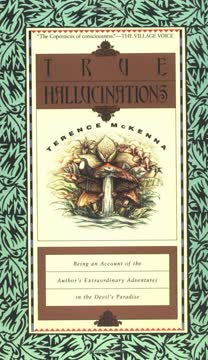



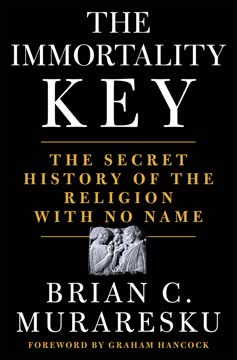
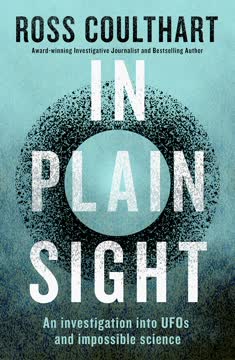
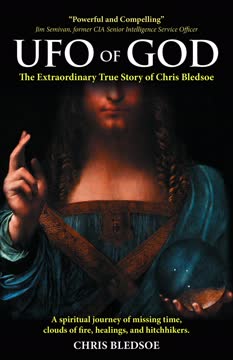
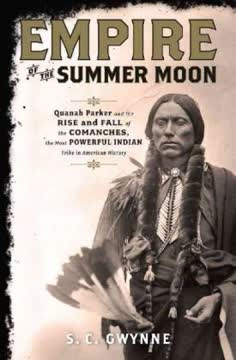

Download PDF
Download EPUB
.epub digital book format is ideal for reading ebooks on phones, tablets, and e-readers.
